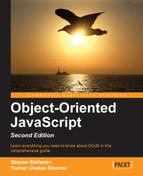JavaScript functions are objects. They can be defined using the
Function constructor, like so:
var sum = new Function('a', 'b', 'return a + b;'),This is a (generally not recommended) alternative to the function literal (also known as function expression):
var sum = function (a, b) {
return a + b;
};Or, the more common function definition:
function sum(a, b) {
return a + b;
}|
Property/Method | |
|---|---|
|
Allows you to call another function while overwriting the other function's this value. The first parameter that function whatIsIt(){
return this.toString();
}
> var myObj = {};
> whatIsIt.apply(myObj);
"[object Object]"
> whatIsIt.apply(window);
"[object Window]"
| |
|
The same as | |
|
The number of parameters the function expects. > parseInt.length;
2
If you forget the difference between call() and apply(): > Function.prototype.call.length; 1 > Function.prototype.apply.length; 2 The call() property's length is 1 because all arguments except the first one are optional. |
